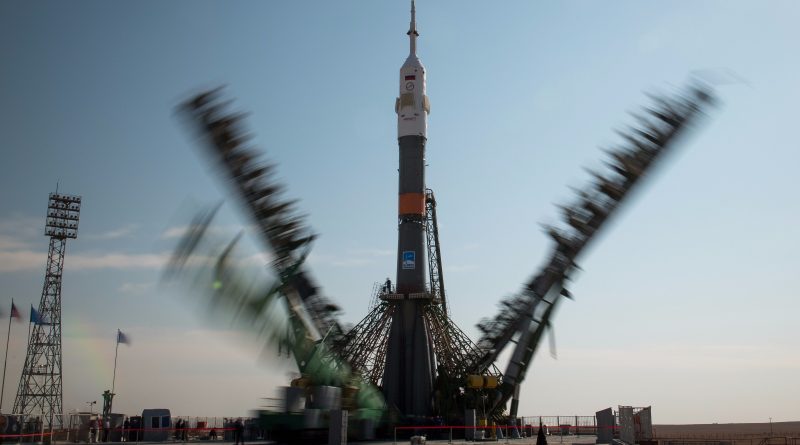U.S.-Russian Crew Trio on the Eve of Liftoff on 167-Day Space Flight
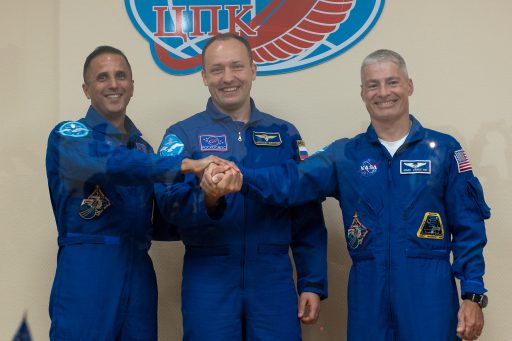
Two NASA Astronauts and an experienced Cosmonaut are on the eve of their launch to the International Space Station on a five-and-a-half-month mission as part of Expedition 53/54. Soyuz Commander Aleksandr Misurkin and Flight Engineers Mark Vande Hei and Joe Acaba are targeting a nighttime liftoff from the Baikonur Cosmodrome Tuesday night aboard their Soyuz MS-06 spacecraft, riding into orbit atop Russia’s trusted Soyuz FG rocket.
The 61st Soyuz FG rocket is aiming for liftoff at 21:17:02 UTC, 3:17 a.m. local time, lighting up the night skies as it departs the Site 1/5 launch pad that supported over 500 missions including the launch of Sputnik 60 years ago and Yuri Gagarin’s historic flight in 1961. The International Space Station will pass directly over the Cosmodrome just minutes before liftoff, allowing Soyuz to enter an orbit that catches up with the orbiting laboratory from behind and below.
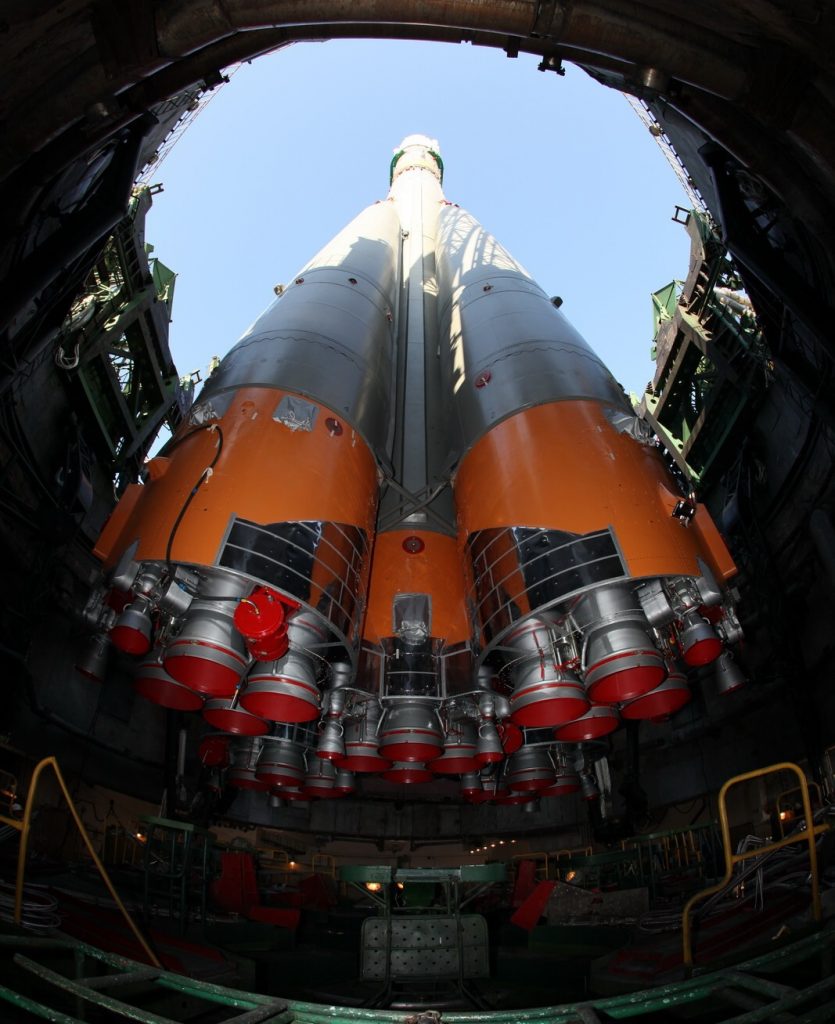
The 305-metric-ton launch vehicle will fire its four strap-on boosters for the first two minutes into the flight, dropping away 50 Kilometers in altitude after helping accelerate the Soyuz to 1.5 Kilometers per second.
Continuing to fire its four-chamber core stage engine, Soyuz will reach the boundary of space two and a half minutes into the flight, allowing the protective payload shroud to be jettisoned to shed no-longer-needed weight. The core stage will hand over to the Block I third stage four minutes and 45 seconds into the flight for a four-minute burn of the upper stage into a 200-Kilometer orbit.
Soyuz MS-06 – the 135th flight of a Soyuz spacecraft – will be released eight minutes and 48 seconds after liftoff to begin its express link-up with the Space Station. The craft will complete a pair of orbit-raising maneuvers on its first lap around the planet and another two will follow on the mission’s second orbit to enable the fully automated rendezvous to begin on Orbit #3. Maneuvering into the vicinity of ISS, Soyuz is set for a slow flyaround and a straight-in approach to the Poisk module, targeting docking at 2:57 UTC on Wednesday.
Soyuz MS-06 is commanded by second-time Soyuz flier Aleksandr Misurkin, embarking on his second long-duration mission to the International Space Station. Misurkin was selected as Cosmonaut in 2006 after serving in the Russian Air Force as 1st class pilot instructor, parachute instructor and scuba diver. He completed his first space flight in 2013, flying to ISS as Flight Engineer on the Soyuz TMA-08M spacecraft & working as Expedition 35/36 Flight Engineer. On his flight, Misurkin logged 166 days in space and performed three spacewalks for a total of 20 hours.
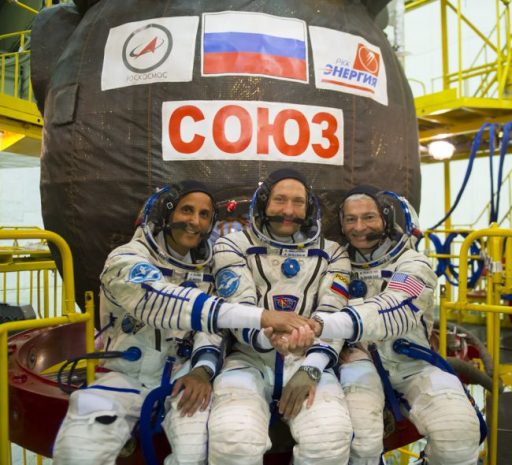
Sitting in the left seat as Soyuz Flight Engineer #1 is NASA’s Mark Vande Hei, setting out on his first flight into space. Vande Hei worked in the U.S. Army’s Space Battalion, providing support in combat operations in Iraq before transitioning to the Johnson Space Center where he was a Capcom for a number of Space Shuttle and International Space Station missions. NASA selected him as Astronaut Candidate in 2009 and he received his first flight assignment in 2015 for ISS Expedition 51/52, though crew shuffles pushed his flight back to Expedition 53/54.
Joe Acaba was called up on relatively short notice as NASA takes advantage of empty seats on Russia’s Soyuz spacecraft that are the result of Russia cutting its permanent ISS crew to two members. The decision was firmed up last November and RSC Energia offered the empty Soyuz seats to Boeing to settle a financial dispute over the dismantling of the Sea Launch endeavor. NASA had planned to increase the U.S. crew contingent on ISS to four with the start of Commercial Crew Flights and decided that getting an additional pair of hands on the USOS segment as early as possible would be beneficial for the overall science program active aboard ISS.
Joe Acaba has two space flights under his belt, flying on Space Shuttle Discovery for 12 days in 2009 on mission STS-119 that delivered the final truss segment to the Space Station. He returned to the orbiting laboratory in 2012 aboard the Soyuz TMA-04M spacecraft, living and working aboard ISS for four months as part of Expedition 31/32, bringing his total time spent in space to 137 days.
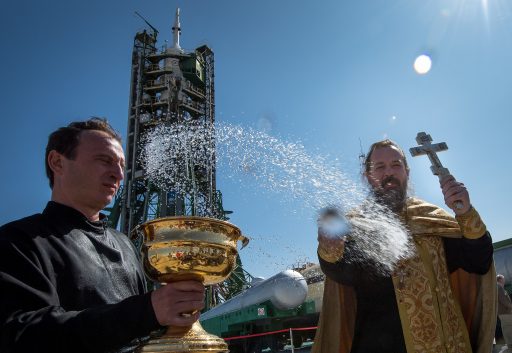
The three crew members had a slightly different launch campaign because training schedules had to be adjusted due to recent crew changes that required Misurkin and Vande Hei to be present at Baikonur in late July as backups for the Soyuz MS-05 mission. Now in a prime crew role, the two returned to Moscow where they were joined by Joe Acaba for final training operations before completing an initial visit to Baikonur in late August to test their suits and inspect their spacecraft, then returning to Moscow for final pre-flight exams, completed by September 5th.
The crew returned to Baikonur last Wednesday to enter pre-flight quarantine, complete a final visit to their Soyuz and participate in pre-flight traditions in place at the storied space port. Their fully assembled Soyuz rocket was rolled to the Site 1/5 launch pad early on Sunday, taking its vertical launch position for two days of testing and final preparations for an eight-hour countdown to be run on Tuesday.
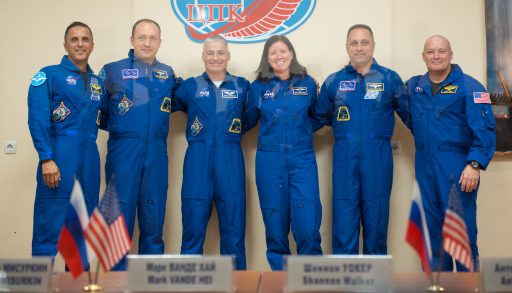
With their training winding down, the crew completed a series of tagups with Mission Control Teams and recovery forces that will be stationed along their ascent ground track for the unlikely event of an in-flight abort. On Monday, the Soyuz rocket received its traditional pre-flight blessing by an Orthodox Priest and the Russian State Commission gave final approval for the prime crew to execute the Soyuz MS-06 mission, marking the final formal hurdle to be cleared prior to launch day.
The three crew members participated in the State Commission meeting before meeting with the press for the final pre-launch news conference. They will be able to sleep in on Tuesday and have a mid-day nap before beginning their launch day activities around 7p.m. local time.
Countdown & Launch Sequence
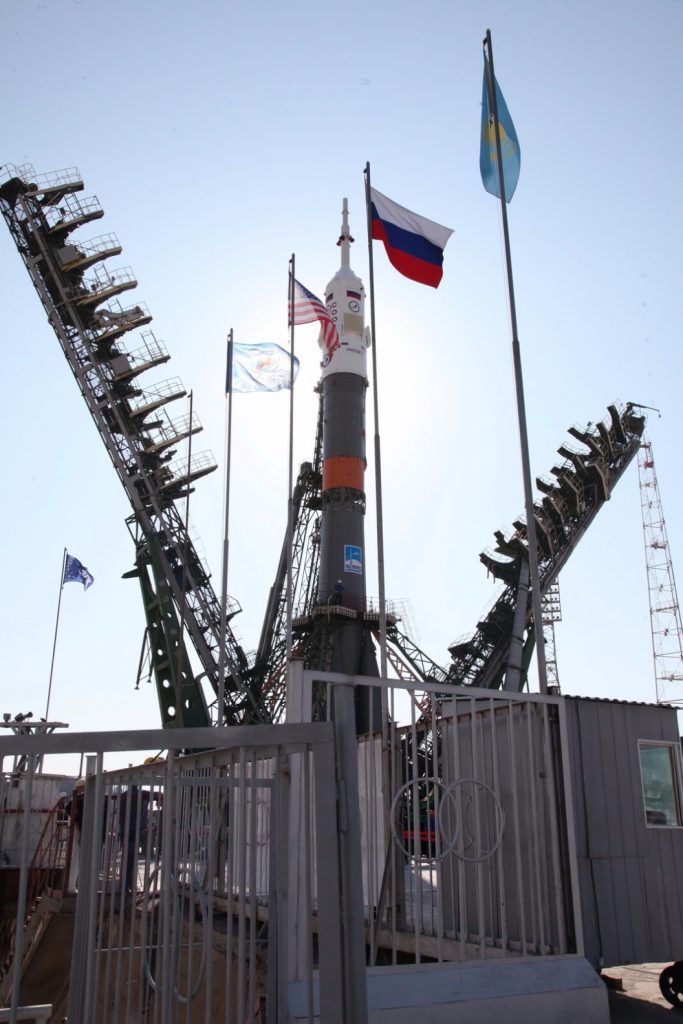
Out at Site 1/5, engineers will initiate the countdown sequence around eight hours prior to launch with the final set of fueling preparations. Once the two vehicles are activated, the Soyuz rocket and spacecraft complete a series of checkouts – communication checks, electrical testing and propulsion system testing is performed in the early stages of the countdown. Completing final hands-on work on the launch vehicle, engineers will install batteries on the booster and remove protective covers before standing by to receive a GO for propellant loading.
Five hours and 30 minutes ahead of launch, the Russian State Commission will meet to look at the overall status of the countdown and the results of launch vehicle and spacecraft testing to provide official approval for the beginning of tanking. By that time, the tanking cars will have already been rolled up to the pad and hooked up to Ground Support Equipment used to deliver propellants to the Soyuz launch vehicle, loaded via the various umbilical masts connected to the different stages of the rocket to deliver propellant, pressurant and electrical connectivity.
Soyuz FG stands 49.5 meters tall and weighs 305,000 Kilograms when fully fueled. It can lift up to 7,200 Kilograms into Low Earth Orbit using a two-stage stack plus four liquid-fueled boosters clustered around the Core Stage – based on the original R7 design by Sergei Korolev.
Each of the boosters is 19.6m long consisting of a tapered and a cylindrical section with a maximum diameter of 2.68m and a launch mass of 43,410 Kilograms. Installed on each booster is a four-chamber RD-107A engine delivering 838.5 Kilonewtons of sea level thrust. The Core Stage is ignited with the boosters and continues to burn after the boosters separate, acting as combined first and second stage. It is 27.8m tall and 2.95 meters in diameter with a total launch mass of 99,500kg, featuring a 792-Kilonewton RD-108A engine and four verniers for vehicle control.
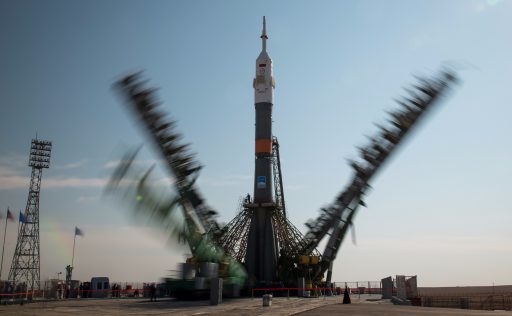
Sitting atop the Core Stage is the Block I third stage that is 6.74m long, 2.66m in diameter and weighs 25,300 Kilograms powered by a four-chamber RD-0110 engine with four vernier thrusters for vehicle control.
Over the course of a two-hour sequence, the boosters, the large Core Stage and the third stage are loaded with a total of 274,140 Kilograms of refined Kerosene and –183°C Liquid Oxygen. Additionally, the boosters and core stage will receive liquid Nitrogen to be heated during flight in order to pressurize the propellant tanks. At around L-3 hrs & 30 min, the boosters and core stage will be loaded with Hydrogen Peroxide to power the engine turbopumps during flight.
Around L-3 hours, the crew will depart Site 254, reporting to officials and boarding a bus for a half-hour ride to Site 1/5 that is hosting its 508th launch. Getting off their bus, the crew members will have a look at their fully fueled rocket, take a few photos with officials present at the pad and walk over to the Service Structure stairs to wave good-bye and enter the elevator taking them up to their Soyuz for crew ingress.
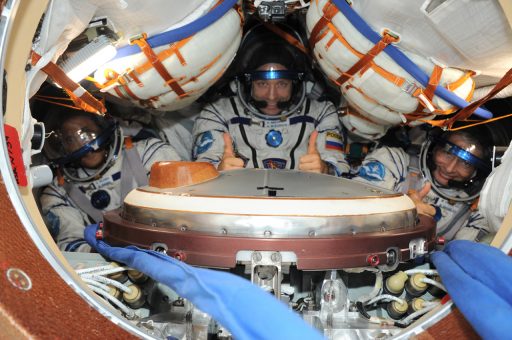
Climbing into the Soyuz through a hatch inside the Launch Shroud, the crew members will – one by one – enter the Orbital Module through its side hatch before climbing down through the Entry Module’s hatch to reach their Kazbek seat liners in the confined space of the small spacecraft.
Leak checks on the spacecraft pick up as soon as Soyuz has been sealed off and the crew will begin working through their pre-launch checklist that will take them about one hour to complete. 60 minutes ahead of launch, the Guidance System is activated and the flight computers receive their flight software 15 minutes later.
As hands-on work at the pad wraps up, teams will retract the two halves of the Soyuz Service Structure at L-40 minutes and put all ground systems in a safe configuration. Half an hour before T-0, the Launch Abort System will be activated and switched to automatic mode – ready to pull the Soyuz to safety in case of any serious problems.
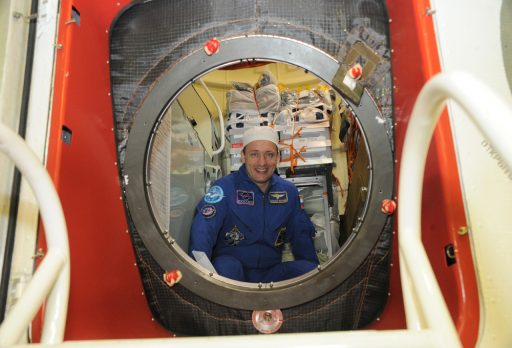
14 minutes ahead of launch, the Soyuz spacecraft is transferred to battery power and at L-10 minutes, the Soyuz FG inertial guidance system is configured for flight as gyros are uncaged and flight recorders are activated. Entering the Automated Countdown Sequence at T-6 minutes, the Soyuz launch vehicle will begin its final reconfigurations as part of a highly choreographed procedure.
Three minutes before launch, the five engines of the boosters and core stage are purged with nitrogen before propellant tank pressurization starts at T-2:35. Transfer to internal power occurs one minute before liftoff and Soyuz enables its Auto Sequencer that controls the final countdown events, coinciding with the retraction of the third stage umbilical mast from the rocket.
With the Auto Sequencer in control of the countdown, the Soyuz starts its ignition sequence at T-20 seconds as the turbopumps of the booster and core stage engines soar to flight speed and the engines reach an intermediate thrust level before being throttled up to full thrust for liftoff.
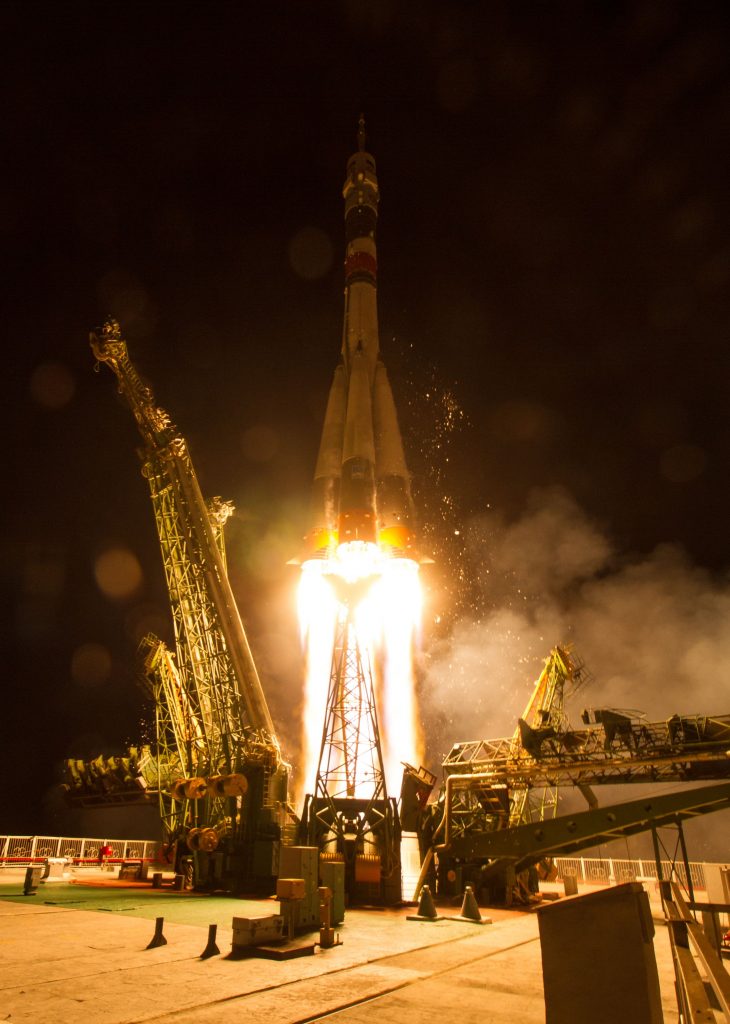
Blastoff is set for precisely 21:17:02 UTC, the optimized launch time based on the latest tracking data of the International Space Station. As clocks hit zero, Soyuz will begin rising from its launch pad with a total launch thrust of 422 metric tons, embarking on a nine-minute ascent mission following the usual flight profile.
Soyuz FG passes through Maximum Dynamic Pressure and Mach 1 a little over 70 seconds into the flight, being powered by the RD-107A engines of the boosters and the RD-108A of the core. The Launch Abort System jettisons its Escape Tower at 114 seconds into the mission, marking the transition from low- to mid-altitude abort mode in a system that provides launch abort capability all the way to orbital insertion.
The four boosters and their RD-107A engines will burn for 1 minute and 58 seconds consuming a total of 39,600kg of propellants each to provide extra boost to the vehicle. After shutdown at an altitude of 49 Kilometers, the boosters are jettisoned from the core for a crash landing 348 Kilometers downrange.
With the boosters tumbling away from the Soyuz rocket, propulsion will only be provided by the Core Stage’s engine, delivering a thrust of 102,000 Kilogram-force when flying in the upper atmosphere. Two minutes and 37 seconds after launch, Soyuz will be over 80 Kilometers in altitude and jettison its protective Launch Shroud giving the crew a view outside through their small Entry Module windows, but the crew members will be focused on their displays, tracking the progress of their ascent into orbit.
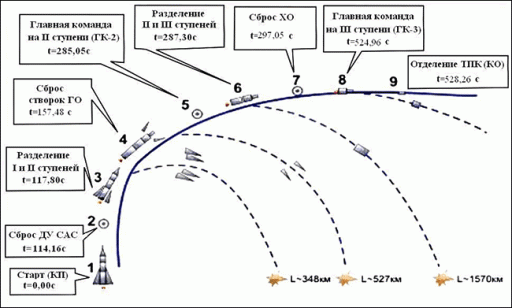
Four minutes and 45 seconds into the flight, the Core Stage will shut down its engine, marking the beginning of the hot staging sequence. Two seconds after cutoff, the third stage’s RD-0110 engine will be commanded to ignite and, at the same time, pyrotechnic bolts in the interstage will be fired to severe the connection between the empty Core Stage and the upper stage of the Soyuz that will continue powered ascent while the core heads toward re-entry and impact 1,570 Kilometers downrange from the launch site.
The third stage will fire its four-chamber engine and four gimbaling verniers for vehicle control until T+8 minutes and 45 seconds to achieve the planned insertion orbit. Just over two seconds after engine shutdown, the Soyuz spacecraft will separate from its rocket stage which itself will open up an oxygen valve to move away from the spacecraft.
Immediately after separation from the carrier rocket, the Soyuz spacecraft will begin executing a series of time-tagged commands with deployment of the two power-generating solar arrays and KURS antennas planned eight seconds after the separation signal is received.
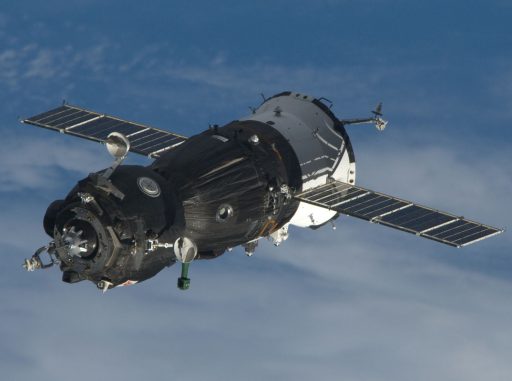
Inside the Entry Module, the crew will not be able to take a break after their exciting ride to space, immediately pressing into a reconfiguration of the Flight Control System and starting a test of KURS. Given the compressed timeline of the four-orbit flight profile, teams have to verify KURS is operational before Soyuz heads out of communications range around seven minutes after orbital insertion.
Mission Control will confirm the KURS system is operating as planned and make a quick spacecraft check to ensure it is safe for the crew to loosen their shoulder straps and open up their helmets as they get settled for a six-hour flight to ISS, their destination in space. Soyuz MS-06 is targeting the standard insertion orbit of 200 by 242 Kilometers inclined 51.67° from where the spacecraft will climb to meet up with ISS, currently orbiting at 401 by 407 Kilometers.
Getting ready to begin its climb up to ISS, Soyuz will pressurize its Unified Propulsion System shortly after separation to enable use of the DPO thrusters to put Soyuz into a stable orientation for power generation and prepare for orbit-raising maneuvers.
Because there is no time to uplink a revised flight plan based on the actual insertion orbit, Soyuz launches with two engine burns already programmed into its computers for execution on the first lap around the Earth. Tracking is completed after liftoff to determine the precise insertion orbit of the Soyuz which is used to calculate the post DV-2 orbit, then input into mission simulations to update burn parameters for the second orbit.
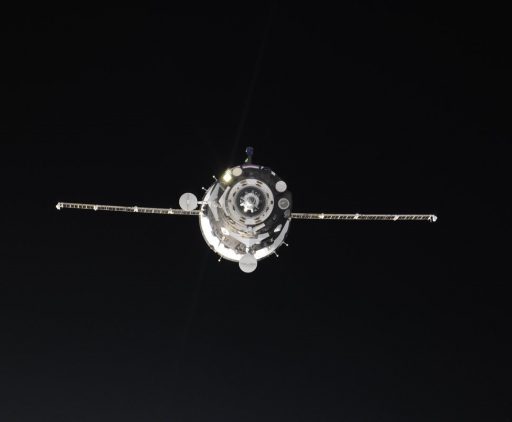
Per the flight design, Soyuz can exit its fast-track rendezvous after the first two DV maneuvers and revert to the 34-orbit flight profile should anything be amiss after the spacecraft’s ride to orbit. Two maneuvers – re-planned with the actual Soyuz injection parameters – will occur on the mission’s second orbit to properly position the Soyuz spacecraft for the initiation of the Automated Rendezvous Sequence on the third orbit.
The DV-5 burn will occur a few minutes after rendezvous initiation and further raise the orbit of the Soyuz, putting it on a path to enter the 200-Kilometer communications zone around ISS where Soyuz will activate its KURS-NA system and its counterpart on ISS will be powered up as well. Initially searching for the signal, Soyuz will lock on KURS and begin calculating range, range rate and the relative geometry between itself and ISS to guide the craft to the vicinity of the Station through a series of Rendezvous Impulse Burns.
A VHF comm link between Soyuz and ISS will be available to provide Mission Control a continuous data and voice link with Soyuz in addition to the Luch relay link which is only available when Soyuz is in an optimized comm attitude, creating drop outs when the spacecraft is maneuvering.
The validity of KURS navigation data will be checked twice, when Soyuz is at 80 Kilometers and closer in at 15 Kilometers to make sure the system is feeding good navigation data to the flight computers.
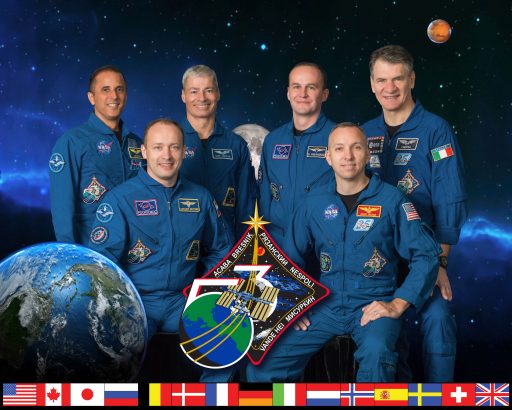
Reaching a distance of 400 meters to ISS, Soyuz will initiate its flyaround sequence to slowly move around the Station to get aligned with the Poisk module. After the seven-minute sequence, Soyuz will come to a stop 200 meters from the docking port, entering a short period of Stationkeeping so that the crew and the ground can check the alignment. Once Mission Control provides a go for final approach, Misurkin will issue the command for Soyuz to pulse its DPO thrusters and initiate a slow closing rate.
With its DPO thrusters, Soyuz will maintain a good alignment as it slowly moves in for docking, planned at a glacial speed of 0.1 meter per second. Contact and capture is expected at 2:57:49 UTC to mark the arrival of three crew members at the Space Station for a 5.5-month stay as part of Expedition 53/54. The exact time of docking will depend on the progress of the flight and the time needed during Stationkeeping.
After docking, Soyuz will retract its docking probe and hooks between the Soyuz and Poisk will be closed to establish a tight coupling between the two spacecraft. Leak checks will be conducted while the crew can finally get out of the Sokol launch and Entry suits before opening up the hatch to ISS at around 4:30 UTC on Wednesday.

